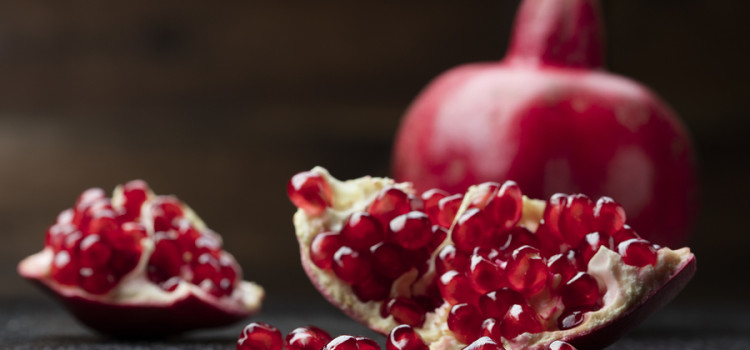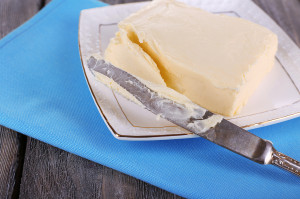The pomegranate fruit is a most striking fruit with its ruby-red exterior, elegant crown and inner pink-red seeds encased by white tissue. The unique flavor of the pomegranate is hard to describe, ranging between sweet and tart, depending on the ripeness and variety of the fruit.

Native from Iran to the Himalayas in northern India, the pomegranate was grown throughout the Mediterranean region since ancient times. Today the fruit is cultivated throughout India, parts of southeast Asia, the East Indies, Malaya and tropical Africa and was introduced into California in 1769 by Spanish settlers (1).
Nowadays, pomegranates can be found easily in the commercial markets of Europe and Northern America. The pomegranate is typically in season between September and February in the Northern Hemisphere and between March and May in the Southern Hemisphere. The juice and seeds of the pomegranate are enjoyed throughout the world and dried seeds are used as a spice in Indian and Pakistani cuisine.
Pomegranate Symbolism
The beautiful pomegranate fruit has been held in high regard for thousands of years in many different cultures, symbolizing a range of different ideas.
In Greek mythology, the pomegranate symbolizes life, marriage and regeneration. In Buddhism, the pomegranate is one of three sacred fruits. In China the pomegranate features heavily in ceramic art and in Christian art, the pomegranate represents eternal life and renaissance. According to Islamic legend, each pomegranate contains one seed that came down from the paradise. The Bedouins in the Middle East view the pomegranate as a symbol of fertility in marriage, as do members of the Hindu faith. Jewish people view the pomegranate as a symbol of fruitfulness and eat it on the Jewish New Year (2).
Potential Health Benefits of Pomegranates
Pomegranates are a good source of folate, vitamins C and K, with a 100g serving of raw pomegranate seeds providing 10% of the daily recommendation for folate, 12% for vitamin C and 16% for vitamin K (3).
The pomegranate has gained popularity in recent years as people have become more aware of the antioxidant potential of the fruit – antioxidants are molecules that protect cells in the body from harmful free radicals. Such radicals result from cigarette smoke, alcohol and are also naturally produced during metabolism in the body. When there are too many free radicals present in the body, oxidative stress can occur, in turn causing cell damage and can ultimately lead to age-related diseases such as cancer, diabetes and heart disease (4).
These antioxidant properties are present in laboratory experiments and are being studied to see how they act in humans (5).
Not only is the pomegranate fruit being researched for its potentially healing properties; the juice of the pomegranate has also been the subject of a number of studies. In one short-term, limited study, the consumption of pomegranate juice was suggested to reduce systolic blood pressure (6). In a clinical trial, it was observed that dialysis patients who drank pomegranate juice three times weekly over the course of year were less likely to require hospitalization due to infections and they also showed less signs of inflammation (7).
Another small clinical trial suggested that pomegranate extract in mouthwash may help control dental plaque (7).
As much as many people enjoy eating this tasty, healthy fruit the clue to what holds many back from buying and eating them can perhaps be learned from the packets of pomegranate seeds on sale in stores. These packets contain the pomegranate seeds after they have already been separated from the pomegranate fruit. The idea of separating the pomegranate seeds from the pomegranate fruit is overwhelming for many people who would rather choose a simple peel-and-eat fruit. In addition, pomegranate juice is notorious for staining clothing.
So, how should you tackle cutting and deseeding this wonderful fruit so that you can enjoy all of its benefits without taking too long or staining your clothes in the process?
Allow us to outline the best method for cutting and deseeding a pomegranate with minimum effort and mess.
- You will need:
- A cutting board
- Newspaper
- A large bowl filled with water
- A sharp knife
- A slotted spoon
- A strainer with small holes
Cutting a Pomegranate- Method:
- Cover the cutting board with newspaper – as we already mentioned, pomegranate juice stains so this will protect your cutting board from getting stained
- Cut a shallow circle around the crown of the pomegranate making sure not to push the knife in too deeply
- Pop the crown off like a lid. You’ll be able to see the internal sections of the pomegranate which are divided by white pith lines.
- Score the skin of the pomegranate from the top to the bottom of the fruit by cutting along the white pith lines. You don’t want to cut deeply through and slice seeds.
- Pull the fruit apart into the sections that you’ve now created
- Remove any large, visible pieces of pith
- One by one, submerge the sections of the pomegranate in the large bowl of water and break them up underneath the water. Separate the seeds from the rind and pith.
- As you separate the seeds from the rest of the fruit the seeds will sink to the bottom of the bowl whereas the pith with rise to the top and float. Throw out large chunks of rind.
- When you finish de-seeding the segments, use a slotted spoon to remove floating debris from the surface of the water.
- Drain the seeds using the strainer and remove any pith that may still be mixed in with the seeds
- Enjoy!
Other than just snacking on pomegranate seeds on their delicious own or adding them to salad, both sweet and savory, here are some ways to enjoy them:
Crystal Punch Recipe
Pink Grapefruit Mocktail Recipe
Berrygranate Beet Shake Recipe
10 Things We Love About Pomegranate Recipes
Pomegranate Cutting Tips
As far as juicing a pomegranate is concerned, simply pulse the pomegranate seeds in a blender a few times to break them apart and release their juice. It’s important not to blend them for too long because then the seeds will break up entirely which results in cloudy juice. Use a mesh strainer to strain the juice into a container using the back of a spoon to push against the pup in order to extract as much juice as possible.
In order to store pomegranates, keep whole pomegranates at room temperature, out of sunlight for several days or up to three months when refrigerated in plastic bags. Pomegranate seeds can be refrigerated for up to three days or frozen in single layers on trays in airtight containers for up to six months. Be aware that pomegranate seeds often lose their shape when thawed. Pomegranate juice lasts up to three days in the fridge and up to six months in the freezer (8) .
In order to remove pomegranate juice stains from clothing, rinse the stain with cold water until it stops fading. Rub baking soda well into the stain and rinse with cold water until the stain turns a light blue. Boil water and pour it (carefully) from a couple of feet above the stain in such a way that the water passes through and off the fabric. This should take stains entirely out of clothing.
Pomegranate is NOT on this list…
References
1. California Rare Fruit Growers. Pomegranate. Accessed October 30, 2015.
2. Bhandari P R. Pomegranate (Punica granatum L). Ancient seeds for modern cure? Review of potential therapeutic applications. International Journal of Nutrition, Pharmacology, Neurological Diseases. 2012;2(3)171-184. doi: 10.4103/2231-0738.99469.
3. United States Department of Agriculture Research Service. Full Report (All Nutrients): 09286, Pomegranates, raw. Accessed October 30, 2015.
4. European Food Information Council. The science behind superfoods: are they really super? Published November 2012. Accessed October 30, 2015.
5. Mertens-Talcott S, U, Jilma-Stohlawetz P, Rios, J, Hingorani L & Derendorf H. Absorption, Metabolism, and Antioxidant Effects of Pomegranate (Punica granatum L.) Polyphenols after Ingestion of a Standardized Extract in Healthy Human Volunteers. J. Agric. Food Chem. 2006,54(23):8956-8961. doi:10.1021/jf061674h
6. Aviram, M & Dornfeld L. Pomegranate juice consumption inhibits serum angiotensin converting enzyme activity and reduces systolic blood pressure. Atherosclerosis. 2001;158(1);195-198.
7. National Center for Complementary and Integrative Health. Pomegranate. Published November 2014. Updated October 21, 2015. Accessed October 30, 2015.
8. Pomegranate Council. FAQ. Accessed October 30, 2015.




I put a whole pomegranate into a juicer (nutribullet) after top and tailing, is this ok?
It is extremely nice but after reading your article I wonder am I harming myself by putting the sucking ans all in?
Hi, Davbat. All parts of the pomegranate are good for you. No worries! 🙂